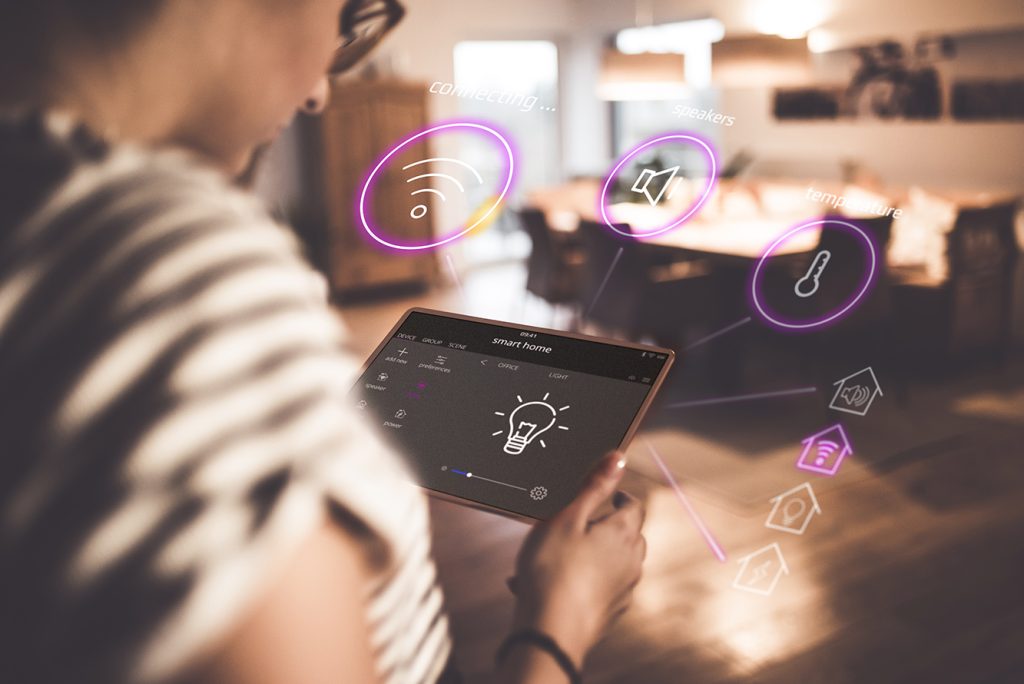What if you could walk into a customer’s home, test the configuration of their disparate network of connected products, identify devices and appliances that are out of date or about to fail and then offer solutions to optimize and ensure their network keeps running smoothly? And you could do this all without causing the customer any disruption or inconvenience?
“Digital twin” is a concept that has promising implications for a wide range of industries, including consumer electronics. It refers to technology that can create a virtual environment that mirrors the real world in order to conduct simulations in a non-invasive way and predict performances and outcomes. It has the potential to shape the future of connected living and enable a more sustainable future.
NASA was one of the originators of this idea back in analog times, when it built physical mockups of space capsules on the ground to help reproduce and solve problems in their vehicles in orbit. Today’s engineers use virtual representations of actual spacecraft to do the same thing.
A digital twin can be built based on data from connected products, sensors, cameras and other IoT equipment and modeled using AI, machine learning, virtual reality and other approaches to replicate the ever-changing real world in real time. As more products become connected, adding to the data flow and complexity of networks, creating such an accurate and dynamic duplicate of a changing environment is essential to testing and calculating the impact of ‘what if’ scenarios.

A Better Connected Home Experience
For retailers, there is the potential to deliver a richer consumer experience from the mix of smart appliances and devices within the connected home. This could include round-the-clock support and protection to ensure the network works continuously and efficiently as new products are added.
A digital twin of the home could be built by tapping into and utilizing the operational data and configuration of connected products, providing a holistic view for testing, remote monitoring and management. Based on the performance and efficiency of devices and appliances, the digital twin could monitor and alert the consumer if servicing or replacing is recommended. For example, once an air conditioning unit, Wi-Fi camera system or washing machine has reached a certain threshold of run time, the digital twin could notify the retailer or manufacturer and the consumer simultaneously and automatically arrange an appointment for maintenance and service or to discuss an upgrade or replacement if needed.
Having a digital replica of a house or an apartment also could enable people to make smarter decisions when renting or purchasing a property. For instance, a digital twin could provide the consumer with a 360-degree view of the premises, including the condition and age of existing appliances and devices, the length of time they’ve been operating, service history, energy consumption and so on. Once a person moves in, appliance and device manufacturers could get notified, enabling them to proactively reach out to offer services and maintenance for the onsite products.
A More Sustainable Future
In addition to providing a better user experience, digital twin technology has the potential to help create a more sustainable environment by optimizing trade-in and upgrade programs for a wide range of connected home devices and appliances. Knowing the age, usage and performance of a connected product, retailers and other electronics providers could proactively provide the customer with a trade-in offer to upgrade to newer models. This would promote new sales and incentivize consumers to return their used devices, which can be refurbished and resold in the secondary market, extending their life and feeding the circular economy.
I can tell you firsthand as part of Assurant, which has repurposed more than 125 million devices, that such efforts have a significant impact on keeping e-waste out of landfills and improving connectivity for many who could not otherwise afford it through access to affordable pre-owned technology.
Current Use Cases
Digital twins are already being utilized in several industries, including manufacturing, automotive, logistics and healthcare. Applications include new product development, facility configuration and performance, autonomous vehicle testing, process optimization and predictive maintenance.
While there are examples like Sofi Stadium, home to the LA Rams and LA Chargers, which has its own digital twin to help manage, maintain and operate the building, most current use cases can be found among energy plants and industrial operations. An aluminum smelting factory in China has created a digital twin in which they model and test operational processes and worker/machine configuration and interaction. Complex modeling has led to solutions that have resulted in a 90 million kW/hour reduction in power usage, roughly equivalent to the energy consumption of 13,000 residents in New York City.
It’s still early days. The potential of digital twins to enable enterprises to improve efficiency and performance, to transform homes and connected lifestyles and to promote greater environmental sustainability is just starting to come into focus. However, the promise is there for utilizing the technology to help businesses and consumers alike thrive in a connected world.

Jeff is the President, U.S. Connected Living, at Assurant, a global provider of risk management products and services with headquarters in New York City. Its businesses provide a diverse set of specialty niche-market insurance products in the property, casualty, extended service protection and pre-need insurance sectors.















